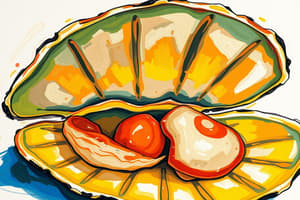Podcast
Questions and Answers
What are the three taxonomic classifications for clams?
What are the three taxonomic classifications for clams?
- Animalia, Mollusca, Bivalvia (correct)
- Animalia, Arthropoda, Bivalvia
- Animalia, Mollusca, Insecta
- Plantae, Mollusca, Bivalvia
Why are clams called bivalves?
Why are clams called bivalves?
Bi means 2, valve means shell.
What are siphons and what is their purpose?
What are siphons and what is their purpose?
They are filters through which water is sucked; this allows only food particles to enter the clam.
Adults are usually sessile, but the larva or ______________ is free swimming.
Adults are usually sessile, but the larva or ______________ is free swimming.
Body organs make up the ___________ mass.
Body organs make up the ___________ mass.
What is the oldest part of a clam's shell called and how can it be located?
What is the oldest part of a clam's shell called and how can it be located?
What do the rings on the clam's shell indicate?
What do the rings on the clam's shell indicate?
Name the clam's siphons.
Name the clam's siphons.
What holds the two shells together?
What holds the two shells together?
What muscles open and close the clam?
What muscles open and close the clam?
Describe the inside lining of the shell.
Describe the inside lining of the shell.
What is the function of the tooth-like projections at the dorsal edge of the clam's valves?
What is the function of the tooth-like projections at the dorsal edge of the clam's valves?
Where is the mantle located in the clam, and what is its function?
Where is the mantle located in the clam, and what is its function?
Describe the clam's foot.
Describe the clam's foot.
What is the mantle cavity?
What is the mantle cavity?
How do clams breathe?
How do clams breathe?
What helps direct water over the gills?
What helps direct water over the gills?
Where are the palps found and what is their function?
Where are the palps found and what is their function?
Describe the movement of food from the current siphon through the digestive system of the clam.
Describe the movement of food from the current siphon through the digestive system of the clam.
Where is the clam's heart located?
Where is the clam's heart located?
Why are clams referred to as 'filter feeders'?
Why are clams referred to as 'filter feeders'?
What are the parts of the clam's nervous system?
What are the parts of the clam's nervous system?
What are some miscellaneous characteristics of clams?
What are some miscellaneous characteristics of clams?
Flashcards are hidden until you start studying
Study Notes
Clam Anatomy and Function
- Clams belong to Kingdom Animalia, Phylum Mollusca, and Class Bivalvia/Pelecypoda.
- Called bivalves due to having two shells (valves).
- Siphons filter water to allow only food particles to enter the clam.
- Larvae known as trocophore are free-swimming; adult clams are usually sessile.
Shell Structure
- The oldest part of a clam's shell is the umbo, characterized by its coiled, hump-like structure with tight rings.
- Rings on the shell indicate age; more rings represent older clams.
- Hinge ligaments hold the two shells together.
- Adductor muscles are responsible for opening and closing the clam.
Interior Features
- The inside lining of the shell is called nacre, soft and smooth, providing protection.
- Dorsal edge of the valves has tooth-like projections that ensure the proper alignment of shells for a tight seal.
Mantle and Foot
- The mantle is located midway on the anterior surface and secretes the shell while also serving a respiratory function.
- The clam's foot is wedge or axe-shaped, aiding in digging.
Mantle Cavity and Breathing
- The mantle cavity is the large space between mantle lobes, where water flows over food and visceral mass.
- Clams breathe using two pairs of feathery gills, where oxygen diffuses for respiration.
- Cilia on the gills help direct water over them.
Digestive and Nervous System
- Labial palps, located at the anterior end of gills, direct trapped food towards the mouth.
- Food movement follows this pathway: plankton → incurrent siphon → mucous on gills → cilia to labial palps → mouth → stomach → intestine → anus → excurrent siphon.
- Clams have a primitive nervous system with ganglia and nerve cords but lack a formal structure.
Reproduction and Circulatory System
- Clams are filter feeders, trapping plankton from water for digestion.
- They possess an open circulatory system, with distinct reproductive methods: marine clams undergo external fertilization, while freshwater clams use internal fertilization.
- Clams are invertebrates, protostomes, and exhibit no cephalization.
Studying That Suits You
Use AI to generate personalized quizzes and flashcards to suit your learning preferences.




